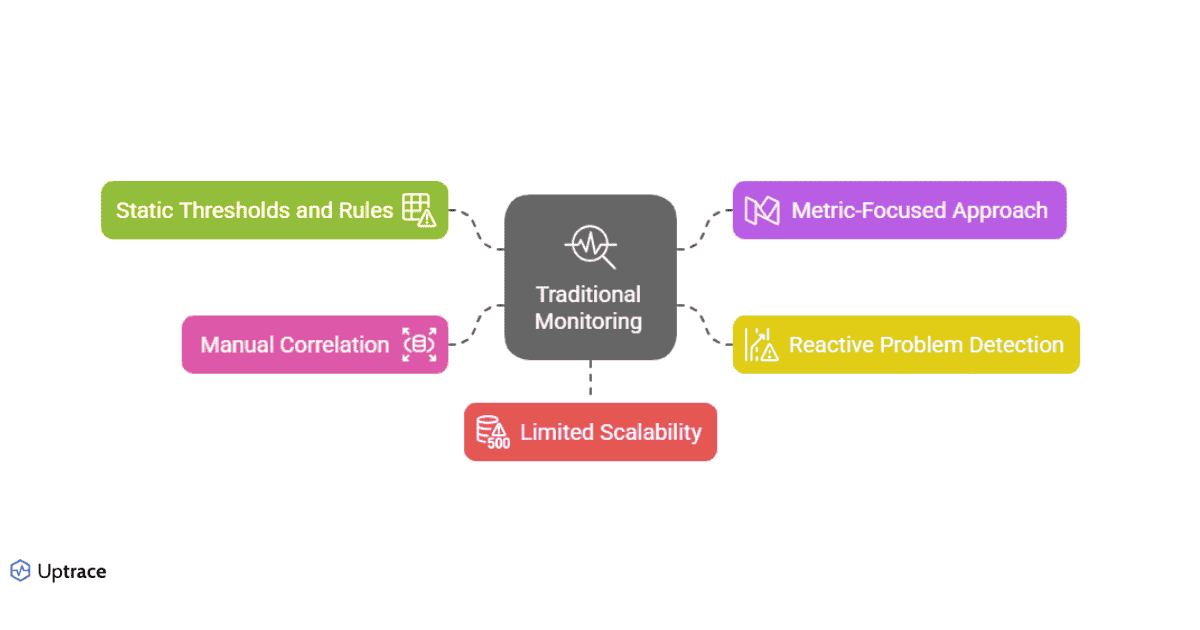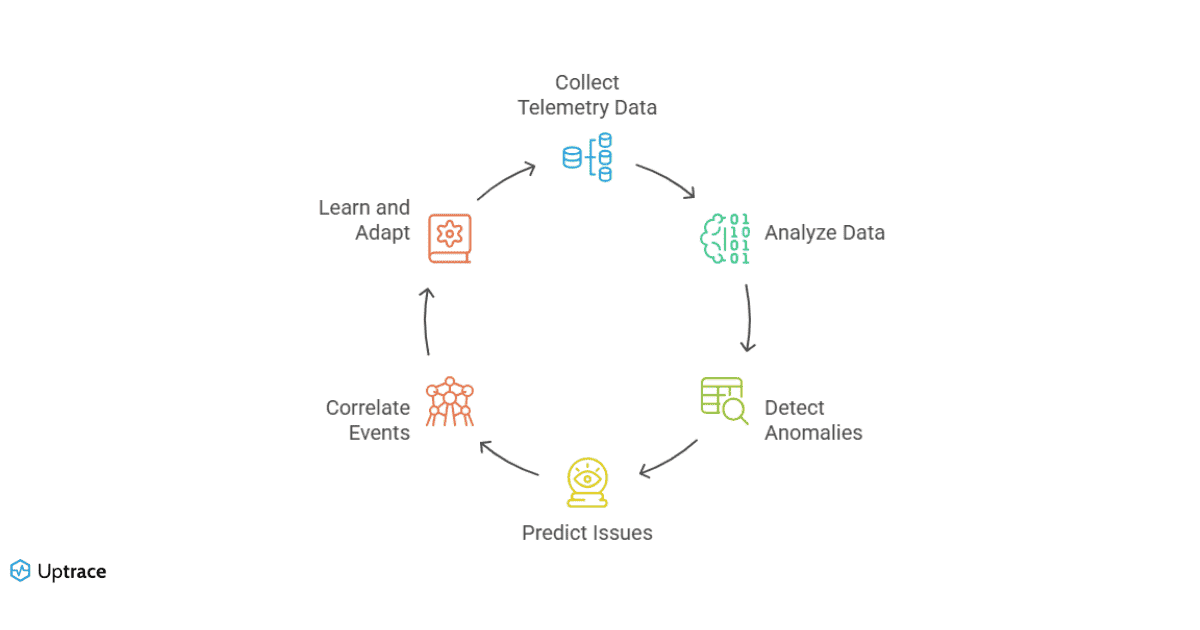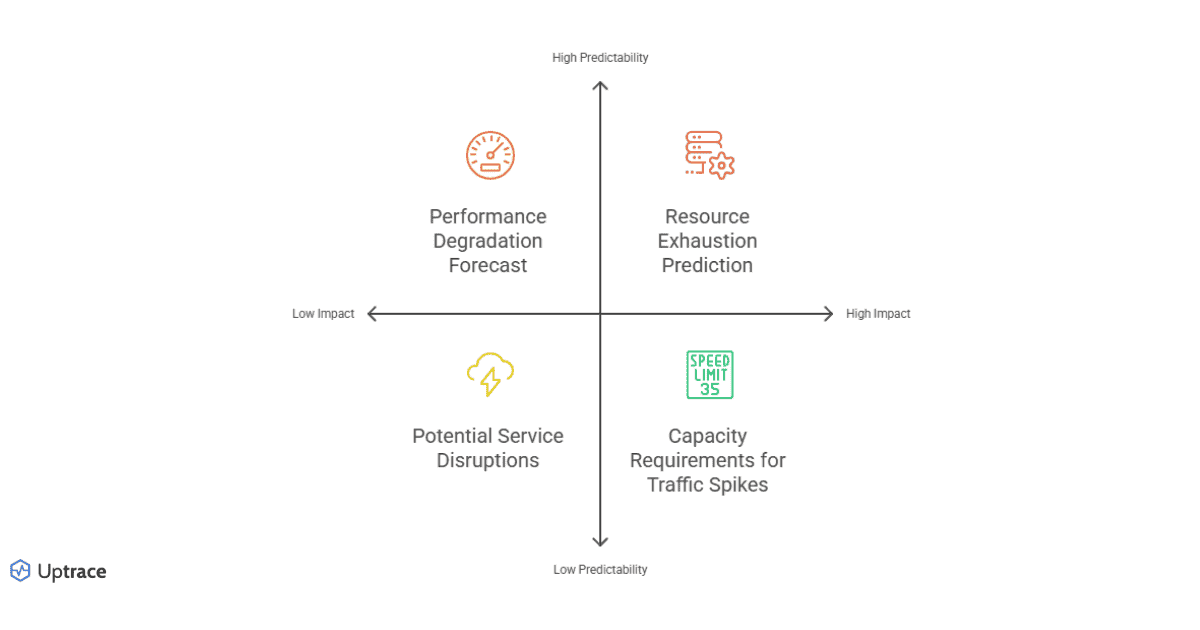From Traditional Monitoring to AI-Enhanced Observability
Limitations of Traditional Monitoring
Traditional monitoring approaches have served IT operations for decades, providing basic visibility into system health through predefined metrics and thresholds. However, these conventional methods face significant limitations when confronted with modern, complex environments:
Static Thresholds and Rules
Traditional monitoring relies heavily on manually defined thresholds and rules. These static configurations cannot adapt to changing conditions, leading to alert storms during unexpected but normal variations, or missed alerts for subtle issues that fall below predefined thresholds.
Metric-Focused Approach
Conventional tools concentrate primarily on collecting and displaying metrics, offering limited context about the relationships between different system components. This makes it difficult to understand the broader impact of performance anomalies or to identify root causes.
Reactive Problem Detection
Traditional monitoring is inherently reactive, identifying issues only after they've occurred and often after they've impacted users. This approach doesn't support proactive identification of emerging problems before they reach critical states.
Manual Correlation
When incidents occur, operations teams must manually correlate data from multiple sources and systems to understand the full scope and cause of issues. This time-consuming process extends mean time to resolution (MTTR) and increases operational burden.
Limited Scalability
As environments grow in complexity and scale, traditional monitoring tools struggle to keep pace. The explosion of telemetry data from microservices, containers, and distributed systems overwhelms human operators and conventional analysis methods.

AI-Enhanced Observability: What It Is
AI-enhanced observability represents a fundamental evolution in how organizations monitor and understand their systems. It combines the three pillars of observability — metrics, logs, and traces with artificial intelligence to provide deeper insights and automate complex analysis tasks.
At its core, AI-enhanced observability uses machine learning and other AI techniques to:
- Analyze massive volumes of telemetry data at a scale beyond human capability
- Detect patterns and anomalies that would be invisible to traditional threshold-based monitoring
- Predict potential issues before they impact system performance or user experience
- Automatically correlate events across distributed systems to identify root causes
- Continuously learn and adapt to evolving system behaviors and patterns
This approach transforms observability from a primarily visualization-focused discipline to an intelligent system that can interpret data, provide context, and even recommend or automate remediation actions.

Practical Applications of AI in Observability
AI-enhanced observability isn't just a theoretical concept—it's being applied in various ways across modern IT operations:
Anomaly Detection
Traditional monitoring relies on predefined thresholds to trigger alerts, often leading to alert fatigue or missed issues. AI-based anomaly detection instead learns normal patterns of behavior for each metric and alerts only on significant deviations.
# Example configuration of AI-based anomaly detection
anomaly_detection:
algorithm: isolation_forest
training_period: 14d
sensitivity: medium
metrics:
- service.latency
- database.connections
- message_queue.depth
advanced_options:
seasonality: true
trend_analysis: true
This approach dramatically reduces false positives while catching subtle issues that fixed thresholds would miss, such as gradual performance degradation or unusual patterns within "normal" thresholds.
Intelligent Alert Correlation
When incidents occur in complex systems, they often generate dozens or hundreds of related alerts. AI-enhanced observability platforms use machine learning to group related alerts, identify the probable root cause, and suppress redundant notifications.
For example, if a database slowdown triggers alerts from the database itself, connected applications, and downstream services, the system can correlate these alerts, highlight the database as the likely root cause, and minimize alert noise for operators.
Predictive Analytics
Perhaps the most powerful capability of AI-enhanced observability is its ability to predict issues before they impact users. By analyzing historical patterns and current trends, AI models can forecast:
- When a system will run out of resources
- Impending performance degradation
- Potential service disruptions
- Capacity requirements for upcoming traffic spikes
These predictions enable teams to address issues proactively, often automating remediation before users experience any impact.

Natural Language Interfaces
AI-enhanced observability platforms increasingly incorporate natural language processing to allow engineers to interact with monitoring systems using human language. This enables queries like:
- "Show me the latency spikes in the payment service over the last 24 hours"
- "What caused the CPU spike in the recommendation engine last night?"
- "Compare database performance before and after the latest deployment"
These interfaces make observability data more accessible and reduce the learning curve for complex query languages.
Implementing AI-Enhanced Observability
Organizations looking to implement AI-enhanced observability can follow these key steps:
- Build a solid foundation with comprehensive telemetry collection across metrics, logs, and traces
- Ensure data quality by standardizing formats, adding contextual metadata, and maintaining consistent naming conventions
- Start with focused AI use cases that address specific pain points rather than attempting to implement all AI capabilities at once
- Combine domain expertise with AI by involving both operations teams and data scientists in designing and training models
- Implement feedback loops to continuously improve AI model accuracy based on operator input and actual outcomes
It's important to recognize that AI-enhanced observability complements rather than replaces human expertise. The most effective implementations combine AI's pattern recognition and data processing capabilities with human judgment and domain knowledge.
AI and Observability for AI Systems
The emergence of AI agents and systems introduces new monitoring challenges that traditional approaches can't address. AI-enhanced observability is particularly valuable for monitoring these systems because:
- AI systems often exhibit non-deterministic behavior that defies simple threshold-based monitoring
- The relationship between inputs and outputs can be complex and difficult to predict
- Performance characteristics may change over time as models learn and adapt
- Root cause analysis requires understanding both system performance and model behavior
For organizations deploying AI agents or other AI systems, implementing AI-enhanced observability provides the deeper insights needed to ensure reliability, performance, and appropriate behavior.
Future Trends in AI-Enhanced Observability
Key trends to watch include:
- Autonomous remediation where AI systems not only detect and diagnose issues but also implement fixes automatically
- Causal modeling techniques that go beyond correlation to identify true causal relationships in complex systems
- Federated learning approaches that enable AI models to learn from distributed data without centralizing sensitive telemetry
- Explainable AI methods that make the reasoning behind AI-driven alerts and recommendations transparent to operators
- Digital twins that create virtual replicas of production systems for testing and prediction
As these technologies mature, the line between monitoring, observability, and autonomous operations will continue to blur, leading to increasingly self-healing and self-optimizing systems.
Key Takeaways
✓ Traditional monitoring approaches face significant limitations in complex, dynamic environments.
✓ AI-enhanced observability uses machine learning to analyze telemetry data at scale, detect anomalies, predict issues, and correlate events.
✓ Practical applications include anomaly detection, intelligent alert correlation, predictive analytics, and natural language interfaces.
✓ Successful implementation requires solid telemetry foundations, data quality, focused use cases, and human-AI collaboration.
✓ Uptrace provides comprehensive AI-enhanced observability capabilities through its OpenTelemetry-based platform.
FAQ
- How does AI-enhanced observability differ from traditional APM tools?
AI-enhanced observability goes beyond application performance monitoring by incorporating machine learning to detect anomalies without manual thresholds, predict future issues, automatically correlate events across distributed systems, and provide natural language interfaces for easier data access. - Do I need data scientists to implement AI-enhanced observability?
While having data science expertise can be helpful for advanced customization, many modern observability platforms like Uptrace include pre-built AI capabilities that work out of the box without requiring specialized data science skills. - How can I measure the ROI of implementing AI-enhanced observability?
Key metrics include reduction in mean time to detection (MTTD) and resolution (MTTR), decrease in false positive alerts, increase in proactive issue resolution, and reduction in customer-reported incidents. - Can AI-enhanced observability work in highly regulated environments?
Yes, most AI-enhanced observability solutions can be deployed on-premises or in private clouds to meet regulatory requirements. The AI components analyze your telemetry data locally without sending it to external services. - How does AI-enhanced observability handle new or changing systems?
Modern AI approaches are designed to adapt to changing environments. They establish baselines quickly for new services and continuously update their understanding as systems evolve. Some platforms also allow for supervised learning where operators can provide feedback to improve model accuracy.
You may also be interested in: